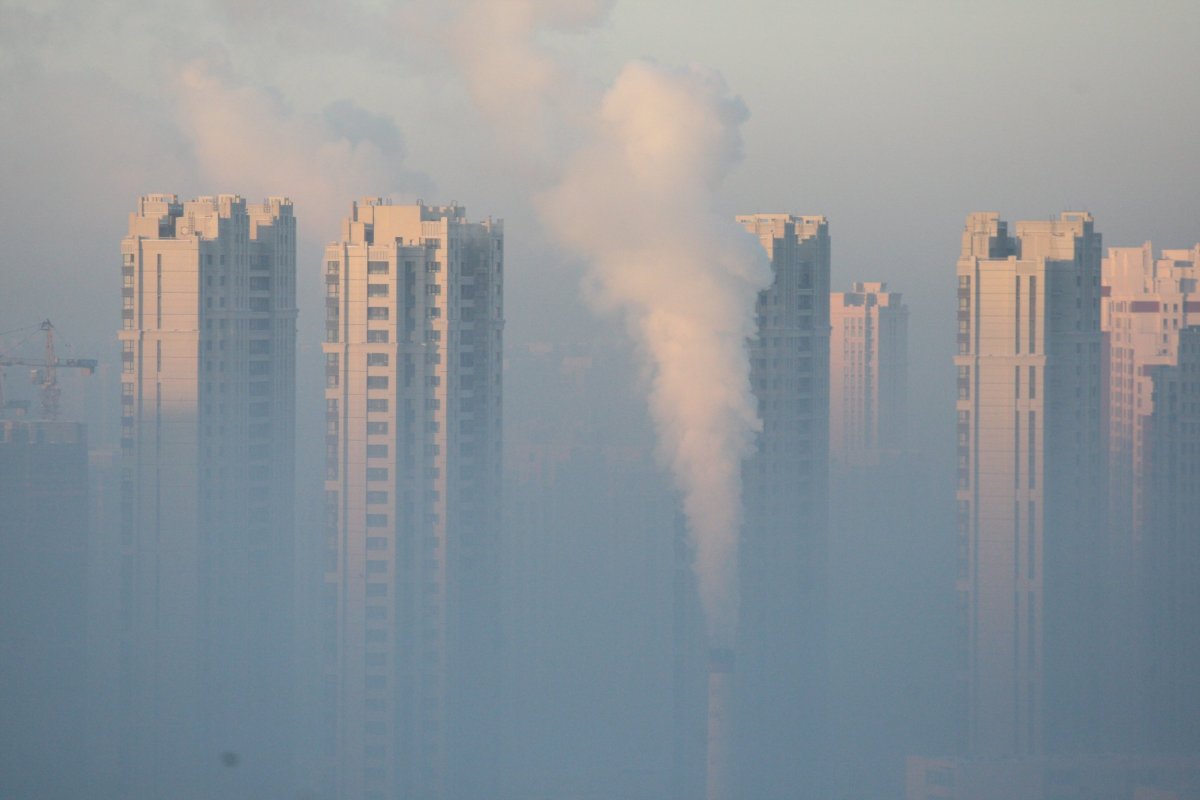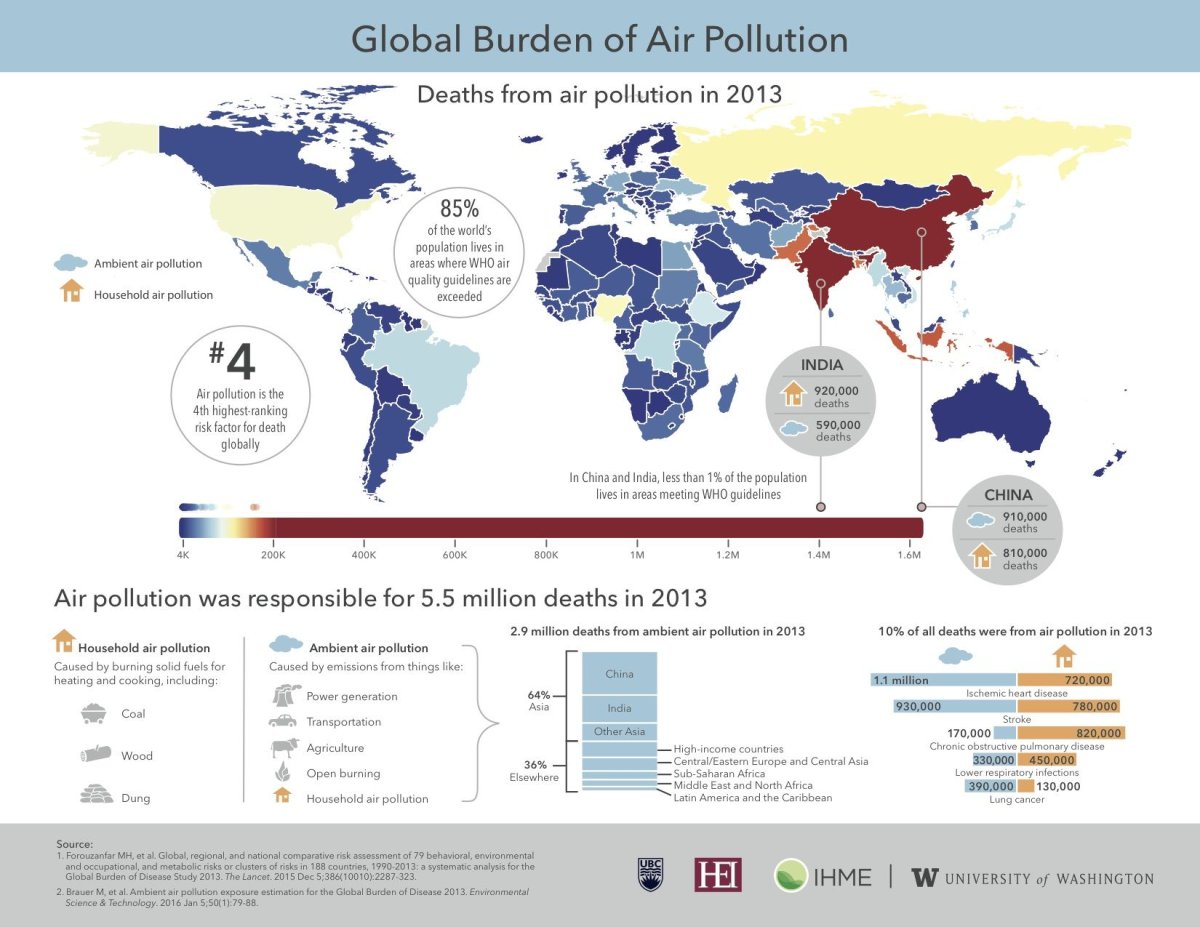You probably don't think of air pollution as a factor that affects how long you will live. It's actually the fourth greatest risk of death, though, right after high blood pressure, dietary risks and smoking. More people die from air pollution than die from alcohol and drug abuse, or unsafe sex. New research from the Global Burden of Disease Study shows that every year 5.5 million people across the world die from diseases—such as cardiovascular disease and stroke—related to air pollution, making it the leading environmental cause of disease by far.
More than 85 percent of the world's population now lives in areas where the World Health Organization Air Quality Guideline is exceeded. Power plants, industrial manufacturing, vehicle exhaust and burning coal and wood all release small particles into the air that are dangerous to a person's health. Indoor and outdoor air pollution in two countries, India and China, account for 55 percent, or 3 million, of those 5.5 million deaths. The study also found that more such deaths are expected over the next two decades unless stricter limits on carbon emissions are imposed.

The Global Burden of Disease Study is an international collaboration that seeks to quantify all the causes of death, disability or ill health around the world. Researchers at the University of British Columbia and the Boston-based, nonprofit Health Effects Institute who review how air pollution levels contribute to those outcomes for the global study have analyzed data from 188 countries gathered between 1990 and 2013.

It's not surprising that people tend to overlook air pollution as an obvious health risk factor, according to researcher Michael Brauer, a professor at the University of British Columbia's School of Population and Public Health in Vancouver. "Air pollution is not that potent to an individual, but everyone is susceptible," he says. "Compare that to smoking, which almost 17 percent of Americans choose to do; 100 percent of people everywhere have no choice but to breathe air."
Of course, breaking air is riskier depending on where you live. Monitors installed over most cities in high-income countries—such as the U.S. and Canada—show that air quality has improved over the study period; and where it's better, so is health. In the past 50 years, North America, Western Europe and Japan have made massive strides to combat pollution by using cleaner fuels, more efficient vehicles, limiting coal burning and putting restrictions on electric power plants and factories. Brauer finds it promising that unlike with many causes of poor health, we know what to do about air pollution and can do so without destroying the economy. "As our economy has grown, we've improved air quality," Brauer says.
In sub-Saharan Africa and most low-income countries where air pollution is the worst, it's much harder to quantify death by air pollution or air pollution levels due to far less sophisticated methods of record keeping. Sometimes Brauer's team has satellite data to work with; other times they rely on surveys and modeling. Once they have adequate information, researchers estimate how much air pollution people in a particular place are exposed to and how many people have a disease affected by air pollution. This allows researchers to determine the relationship between the level of exposure to air pollution and an increase in related diseases.
Brauer imagines that we've probably seen the worst from China where levels of air pollution may have already peaked. The negative effects on people's health are still relevant, however, because the Chinese population is aging and prior exposure to air pollution could still play a role in many diseases. For example, exposure as far back as 20 years ago could influence a person's susceptibility to lung cancer in particular. Heart disease, stroke, lung cancer and chronic lung disease are all diseases disproportionately affecting people over 65 that can be caused by air pollution exposure, even if that exposure was decades old. Even as China takes steps to reduce the amount it pollutes, with so many Chinese entering old age the country will see the impacts of air pollution on health for years to come.
Because India's population is demographically younger than in China, the same issues over aging aren't a concern even as the country has seen a sharp rise in air pollution. A cause for concern is the widespread practice of burning wood and dung for cooking and heating. Millions of families, among the poorest in India, are regularly exposed to high levels of particulate matter in their own homes. The researchers see this in China too, but there government has been somewhat successful educating its people about the negative impact of these practices. India hasn't yet begun to successfully address the risks of indoor pollution among its many rural-based populations.
The good news is that in countries where a concerted effort has been made to reduce air pollution levels, associated deaths have dropped. Still, air pollution exposure is the 13th highest risk factor for death in the U.S., responsible for 80,000 deaths in 2013 alone. That same year, the study found that outdoor air pollution from coal alone in China caused 366,000 deaths. Unless the country adopts even more ambitious efforts to reduce air pollution, Qiao Ma, a Ph.D. student at the School of Environment, Tsinghua University in Beijing, China's research predicts another 990,000 to 1.3 million people will die from exposure by 2030.
Of course, a move to greener forms of energy like wind and solar could have an impact on air pollution and health outcomes throughout the world. "We're hoping our study results catalyze an even faster shift away from using dirty sources of energy," Brauer says. "We know that if you improve air quality everyone benefits."
Uncommon Knowledge
Newsweek is committed to challenging conventional wisdom and finding connections in the search for common ground.
Newsweek is committed to challenging conventional wisdom and finding connections in the search for common ground.
About the writer
To read how Newsweek uses AI as a newsroom tool, Click here.








